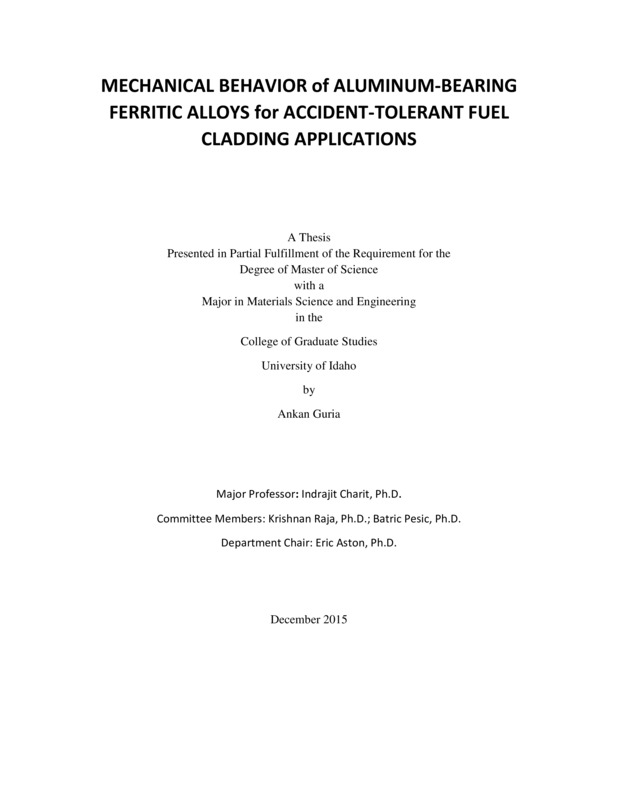MECHANICAL BEHAVIOR of ALUMINUM-BEARING FERRITIC ALLOYS for ACCIDENT-TOLERANT FUEL CLADDING APPLICATIONS
Guria, Ankan. (2015). MECHANICAL BEHAVIOR of ALUMINUM-BEARING FERRITIC ALLOYS for ACCIDENT-TOLERANT FUEL CLADDING APPLICATIONS. Theses and Dissertations Collection, University of Idaho Library Digital Collections. https://www.lib.uidaho.edu/digital/etd/items/guria_idaho_0089n_10769.html
- Title:
- MECHANICAL BEHAVIOR of ALUMINUM-BEARING FERRITIC ALLOYS for ACCIDENT-TOLERANT FUEL CLADDING APPLICATIONS
- Author:
- Guria, Ankan
- Date:
- 2015
- Keywords:
- Accident tolerant fuel cladding materials Aluminium-rich ferritic steels APMT Dynamic strain aging (DSA)
- Program:
- Chemical and Materials Science Engineering
- Subject Category:
- Materials Science; Mechanical engineering; Nuclear engineering
- Abstract:
-
Nuclear power currently provides about 13% of electrical power worldwide. Nuclear reactors generating this power traditionally use Zirconium (Zr) based alloys as the fuel cladding material. Exothermic reaction of Zr with steam under accident conditions may lead to production of hydrogen with the possibility of catastrophic consequences. Following the Fukushima-Daiichi incident, the exploration of accident-tolerant fuel cladding materials accelerated. Aluminum-rich (around 5 wt. %) ferritic steels such as Fecralloy, APMT and APM are considered as potential materials for accident-tolerant fuel cladding applications. These materials create an aluminum-based oxide scale protecting the alloy at elevated temperatures. Tensile deformation behavior of the above alloys was studied at different temperatures (25-500 oC) at a strain rate of 10-3 s-1 and correlated with microstructural characteristics. Higher strength and decent ductility of APMT led to further investigation of the alloy at various combination of strain rates and temperatures followed by fractography and detailed microscopic analyses. Serrations appeared in the stress-strain curves of APMT and Fecralloy steel tested in a limited temperature range (250-400 oC). The appearance of serrations is explained on the basis of dynamic strain aging (DSA) effect due to solute-dislocation interactions. The research in this study is being performed using the funds received from the US DOE Office of Nuclear Energy’s Nuclear Energy University Programs (NEUP).
- Description:
- masters, M.S., Chemical and Materials Science Engineering -- University of Idaho - College of Graduate Studies, 2015
- Major Professor:
- Charit, Indrajit
- Committee:
- Pesic, Batric; Raja, Krishnan
- Defense Date:
- 2015
- Identifier:
- Guria_idaho_0089N_10769
- Type:
- Text
- Format Original:
- Format:
- application/pdf
- Rights:
- In Copyright - Educational Use Permitted. For more information, please contact University of Idaho Library Special Collections and Archives Department at libspec@uidaho.edu.
- Standardized Rights:
- http://rightsstatements.org/vocab/InC-EDU/1.0/

